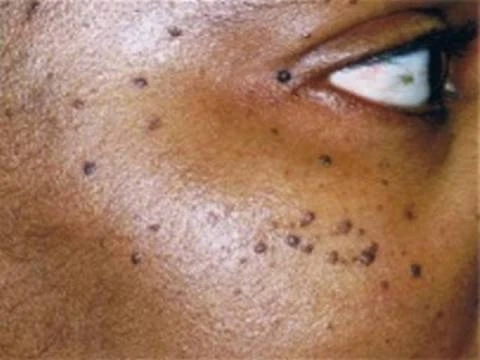Skin tags are a common dermatological issue that can appear on various parts of the body. While they are generally harmless, they can be quite bothersome, especially when they develop on sensitive areas like the eyelid. In this article, we will explore what skin tags are, why they occur on the eyelid, and how to effectively understand and manage them.
What Are Skin Tags?
Skin tags, medically known as acrochordons, are benign growths of skin that often appear as small, soft, and flesh-colored flaps. They typically hang off the skin\'s surface by a thin stalk or peduncle, which can make them look like tiny balloons. Skin tags are not cancerous and do not usually cause pain. They are more of a cosmetic concern than a medical one.
Why Do Skin Tags Develop on the Eyelid?
Skin tags can develop on any part of the body, including the eyelid. The exact cause of skin tags is not fully understood, but several factors may contribute to their formation:
- Friction: Constant rubbing or friction between the eyelid and the eye can irritate the skin, leading to the development of skin tags.
- Genetics: Some people are genetically predisposed to developing skin tags. If your family members have a history of skin tag on eyelid, you may be more likely to get them too.
- Hormones: Hormonal changes, such as those that occur during pregnancy, may trigger the formation of skin tags.
- Obesity: Skin tags are more common in individuals who are overweight or obese, likely due to the increased friction and skin folds in these areas.
- Age: Skin tags tend to become more common as people get older.
While skin tags on the eyelid are generally harmless, they can be bothersome due to their location and potential to interfere with vision or cosmetics.
Understanding the Difference Between Skin Tags and Other Eyelid Conditions
It\'s essential to differentiate skin tags from other eyelid conditions, as this can help determine the appropriate management approach. Some conditions that may resemble skin tags on the eyelid include:
- Moles: Moles are pigmented spots on the skin that can sometimes resemble skin tags. Moles are usually darker in color and have a different texture.
- Warts: Warts are caused by a viral infection and can also appear on the eyelid. They tend to be rougher in texture compared to skin tags.
- Cysts: Cysts are fluid-filled sacs that can develop on the eyelid. They often feel like small, smooth lumps.
- Styes: Styes are painful, red lumps that form near the eyelash line. They are typically caused by a blocked oil gland.
If you\'re uncertain about the growth on your eyelid, it\'s best to consult a healthcare professional or dermatologist for a proper diagnosis.
Managing Skin Tags on the Eyelid
- Consult a Healthcare Professional: Before attempting any removal method, it\'s essential to consult a healthcare professional, preferably a dermatologist or ophthalmologist, to ensure that the growth on your eyelid is indeed a skin tag and not a more serious condition.
- Non-Invasive Options: In many cases, skin tags on the eyelid can be left alone if they are not causing discomfort or interfering with vision. However, if you find them cosmetically bothersome, your healthcare provider may recommend non-invasive removal options, such as freezing (cryotherapy) or cutting (excision). These procedures should only be performed by trained medical professionals to minimize the risk of complications.
- Home Remedies: While it\'s generally not recommended to attempt home removal of skin tags on the eyelid due to the sensitive area, some people choose to try natural remedies like tea tree oil or apple cider vinegar. It\'s crucial to exercise extreme caution when using these methods and to consult with a healthcare provider first.
- Avoid Irritation: If you have skin tags on your eyelid, try to minimize irritation by avoiding rubbing or tugging at them. Be gentle when cleansing your face and eyelids.
- Maintain Proper Eyelid Hygiene: Practicing good eyelid hygiene can help prevent skin tags and other eyelid issues. Use a gentle, hypoallergenic cleanser to clean your eyelids and remove any makeup residue.
- Weight Management: If you are overweight or obese, consider maintaining a healthy weight to reduce the risk of skin tags and other skin conditions.
Conclusion
Skin tags on the eyelid can be a cosmetic concern, but they are generally harmless. Understanding their causes and distinguishing them from other eyelid conditions is essential for effective management. If you have skin tags on your eyelid and are considering removal, it\'s crucial to consult a healthcare professional for guidance on the best course of action. Regardless of whether you choose to remove them or leave them in place, maintaining good eyelid hygiene and minimizing irritation can help keep your eyelid skin healthy.



